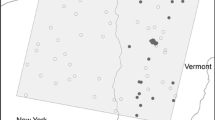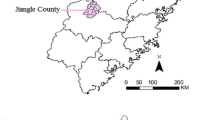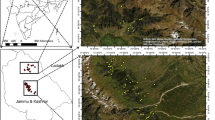Abstract
Heilongjiang province is the largest forest zone in China and the forest coverage rate is 46%. Forests of Heilongjiang province play an important role in the forest ecosystem of China. In this study we investigated the spatial distribution of forest carbon storage in Heilongjiang province using 3083 plots sampled in 2010. We attempted to fit two global models, ordinary least squares model (OLS), linear mixed model (LMM), and a local model, geographically weighted regression model (GWR), to the relationship between forest carbon content and stand, environment, and climate factors. Five predictors significantly affected forest carbon storage and spatial distribution, viz. average diameter of stand (DBH), number of trees per hectare (TPH), elevation (Elev), slope (Slope) and the product of precipitation and temperature (Rain_Temp). The GWR model outperformed the two global models in both model fitting and prediction because it successfully reduced both spatial autocorrelation and heterogeneity in model residuals. More importantly, the GWR model provided localized model coefficients for each location in the study area, which allowed us to evaluate the influences of local stand conditions and topographic features on tree and stand growth, and forest carbon stock. It also helped us to better understand the impacts of silvicultural and management activities on the amount and changes of forest carbon storage across the province. The detailed information can be readily incorporated with the mapping ability of GIS software to provide excellent tools for assessing the distribution and dynamics of the forest-carbon stock in the next few years.
Similar content being viewed by others
References
Anselin L, Bera AK. 1998. Spatial dependence in linear regression models with an introduction to spatial econometrics. Statistics Textbooks and Monographs, 155: 237–290.
Baral A, Guha GS. 2004. Trees for carbon sequestration or fossil fuel substitution: the issue of cost vs. carbon benefit. Biomass and Bioenergy, 27: 41–55.
Bronson DR, Gower ST, Tanner M, Linder S, Van Herk I. 2008. Response of soil surface CO2 flux in a boreal forest to ecosystem warming. Global Change Biology, 14: 856–867.
Brown S. 2002. Measuring carbon in forests: current status and future challenges. Environmental Pollution, 116:363–372.
Brunsdon C, Fotheringham AS, Charlton M. 1999. Some notes on parametric significance tests for geographically weighted regression. Journal of Regional Science, 39:497–524.
Brunsdon C, Fotheringham AS, Charlton M. 2002. Geographically weighted summary statistics — A framework for localized exploratory data analysis. Computers, Environment and Urban Systems, 26:501–524.
Brunsdon C, Fotheringham AS, Charlton ME. 1996. Geographically weighted regression: A method for exploring spatial nonstationarity. Geographical Analysis, 28: 281–298.
Charlton M, Fotheringham S, Brunsdon C. 2009. Geographically weighted regression. White paper. National Centre for Geocomputation. National University of Ireland Maynooth.
Chi GQ. 2010. The impacts of highway expansion on population change: An integrated spatial approach. Rural Sociology, 75:58–89.
Chi W, Qian XY. 2009. The role of education in regional innovation activities and economic growth: spatial evidence from China. Available at: http://mpra.ub.uni-muenchen.de/id/eprint/15779
Daoyi G, Peijun S. 2004. Inter-annual changes in Eurasian continent NDVI and its sensitivity to the large-scale climate variations in the last 20 years. Acta Botanica Siniea, 46:186–193.
Du HQ, Zhou GM, Fan WY, Ge HL, Xu XJ, Shi YJ, Fan WL. 2010. Spatial heterogeneity and carbon contribution of aboveground biomass of moso bamboo by using geostatistical theory. Plant Ecology, 207:131–139.
Echalar F, Gaudichet A, Cachier H, Artaxo P. 1995. Aerosol emissions by tropical forest and savanna biomass burning: Characteristic trace elements and fluxes. Geophysical Research Letters, 22: 3039–3042.
Espa G, Arbia G, Giuliani D. 2013. Conditional versus unconditional industrial agglomeration: disentangling spatial dependence and spatial heterogeneity in the analysis of ICT firms’ distribution in Milan. Journal of Geographical Systems, 15: 31–50.
Fahey TJ, Woodbury PB, Battles JJ, Goodale CL, Hamburg SP, Ollinger SV, Woodall CW. 2009. Forest carbon storage: ecology, management, and policy. Frontiers in Ecology and the Environment, 8: 245–252.
Falkowski P, Scholes RJ, Boyle EEA, Canadell J, Canfield D, Elser J, Gruber N, Hibbard K, Högberg P, Linder S. 2000. The global carbon cycle: A test of our knowledge of earth as a system. Science, 290: 291–296.
Fang JY, Chen AP, Peng CH, Zhao SQ, Ci LJ. 2001. Changes in forest biomass carbon storage in China between 1949 and 1998. Science, 292: 2320–2322.
Fotheringham AS, Brunsdon C, Charlton M. 2002. Geographically weighted regression: the analysis of spatially varying relationships. Wiley and Sons, p.269.
Fotheringham AS, Charlton ME, Brunsdon C. 2001. Spatial variations in school performance: A local analysis using geographically weighted regression. Geographical and Environmental Modeling, 5: 43–66.
Granier A, Ceschia E, Damesin C, Dufrêne E, Epron D, Gross P, Lebaube S, Le DV, Le GN, Lemoine D. 2000. The carbon balance of a young beech forest. Functional Ecology, 14: 312–325.
Guo L, Ma Z, and Zhang L. 2008. Comparison of bandwidth selection in application of geographically weighted regression: a case study. Canadian Journal of Forestry Research, 38: 2526–2534.
Hazlett PW, Gordon AM, Sibley PK, Buttle JM. 2005. Stand carbon stocks and soil carbon and nitrogen storage for riparian and upland forests of boreal lakes in northeastern Ontario. Forest Ecology and Management, 219: 56–68.
Heath LS, Smith JE. 2000. An assessment of uncertainty in forest carbon budget projections. Environmental Science and Policy, 3:73–82.
HLJFOREST. 2014. http://www.hljforest.gov.cn/
Houoatow RA. 1997. Terrestrial carbon storage: global lessons for Amazonian research. Ciencia e Cultura Sao Paulo, 49: 58–72.
Johnston K, Ver JM, Krivoruchko K, Lucas N. 2001. Using ArcGIS geostatistical analyst. Esri Redlands.
Kurz WA, Apps MJ. 1999. A 70-year retrospective analysis of carbon fluxes in the Canadian forest sector. Ecology Applications, 9: 526–547.
Kurz WA, Stinson G, Rampley GJ, Dymond CC, Neilson ET. 2008. Risk of natural disturbances makes future contribution of Canada’s forests to the global carbon cycle highly uncertain. Proceedings of the National Academy of Sciences, 105: 1551–1555.
Law BE, Thornton PE, Irvine J, Anthoni PM, Van TS. 2001. Carbon storage and fluxes in ponderosa pine forests at different developmental stages. Global Change Biology, 7: 755–777.
Lindesay JA, Andreae MO, Goldammer JG, Harris G, Annegarn HJ, Garstang M, Scholes RJ, Van BW. 1996. International geosphere-biosphere programme/international global atmospheric chemistry SAFARI-92 field experiment: Background and overview. Journal of Geophysical Research, 101: 23521–23523, 530.
Littell RC, Milliken WW, Stroup RD, Wolfinger A. 2006. SAS for mixed models. 2 nd Ed. Cary, USA: SAS Press, p.441.
Lu J, Zhang L. 2011. Modeling and prediction of tree height-diameter relationships using spatial autoregressive models. Forest Science, 57: 252–264.
Lu J, Zhang L. 2012. Geographically local linear mixed models for tree height-diameter relationship. Forest Science, 58:75–84.
Ma Z, Zuckerberg B, Porter WF, Zhang L. 2011. Use of localized descriptive statistics for exploring the spatial pattern changes of bird species richness at multiple scales. Applied Geography, 32: 185–194.
Myeong S, Nowak DJ, Duggin MJ. 2006. A temporal analysis of urban forest carbon storage using remote sensing. Remote Sensing and Environment, 101: 277–282.
Neilson ET, MacLean DA, Meng F, Arp PA. 2007. Spatial distribution of carbon in natural and managed stands in an industrial forest in New Brunswick, Canada. Forest Ecology and Management, 253: 148–160.
Nelson R, Krabill W, Tonelli J. 1988. Estimating forest biomass and volume using airborne laser data. Remote Sensing and Environment, 24: 247–267.
Phillips DL, Brown SL, Schroeder PE, Birdsey RA. 2000. Toward error analysis of large — scale forest carbon budgets. Global Ecology and Biogeography, 9: 305–313.
Pickett S, Cadenasso ML. 1995. Landscape ecology: spatial heterogeneity in ecological systems. Science, 269: 331–334.
Sales MH, Souza CM, Kyriakidis PC, Roberts DA, Vidal E. 2007. Improving spatial distribution estimation of forest biomass with geostatistics: A case study for Rondônia, Brazil. Ecological Modeling, 205: 221–230.
SAS Institute, Inc. 2011. SAS/STAT Users’ guide. Version 9.3. Cary, NC: SAS Institute, Inc..
Shi H, Zhang L. 2003. Local analysis of tree competition and growth. Forest Science, 49: 938–955.
Shi H, Zhang L, Liu J. 2006. A new spatial-attribute weighting function for geographically weighted regression. Canadian Journal of Forest Research, 36: 996–1005.
Smith JE, Heath LS, Skog KE, Birdsey RA. 2006. Methods for calculating forest ecosystem and harvested carbon with standard estimates for forest types of the United States. United States Department of Agriculture, Forest Service, Northeastern Research Station.
Sohngen B, Mendelsohn R. 2003. An optimal control model of forest carbon sequestration. American J. Agricultural Economics, 85: 448–457.
Tang SZ, Zhang HR, Xu H. 2000. Study on establish and estimate method of compatible biomass model. Scientia Silvae Sinicae, 36: 19–27. (in Chinese)
Valentini R, Matteucci G, Dolman AJ, Schulze E, Rebmann C, Moors EJ, Granier A, Gross P, Jensen NO, Pilegaard K. 2000. Respiration as the main determinant of carbon balance in European forests. Nature, 404: 861–865.
Wofsy SC, Harriss RC. 2002. The North American Carbon Program (NACP). Report of the NACP Committee of the US Interagency Carbon Cycle Science Program. US Global Change Research Program, Washington, DC 59.
Zhang L, Bi H, Cheng P, Davis CJ. 2004. Modeling spatial variation in tree diameter-height relationships. Forest Ecology and Management, 189: 317–329.
Zhang L, Gove JH. 2005. Spatial assessment of model errors from four regression techniques. Forest Science, 51:334–346.
Zhang L, Gove JH, Heath L. 2005. Spatial residual analysis of six modeling techniques. Ecological Modeling, 186: 154–177.
Zhang L, Ma Z, Guo L. 2009. An evaluation of spatial autocorrelation and heterogeneity in the residuals of six regression models. Forest Science, 55: 533–548.
Zhang L, Shi H. 2004. Local modeling of tree growth by geographically weighted regression. Forest Science, 50: 225–244.
Zhen Z, Li FR, Liu ZG, Liu C, Zhao YL, Ma ZH, Zhang L. 2013. Geographically local modeling of occurrence, count, and volume of downwood in Northeast China. Applied Geography, 37: 114–126.
Zhou XJ, Wang FL, Wu YY, Na JH, Pan HS, Wang Y. 2013. Analysis of temperature change characteristics of Heilongjiang Province, northeast China and whole country in recent 60 years. Journal of Natural Disasters, 22(2):124–129. (in Chinese).
Author information
Authors and Affiliations
Corresponding author
Additional information
Project funding: This research was financially supported by the Scientific Research Funds for Forestry Public Welfare of China (Granted No. 201004026) and the Program for Changjiang Scholars and Innovative Research Team in University (IRT1054).
Corresponding editor: Chai Ruihai
Rights and permissions
About this article
Cite this article
Liu, C., Zhang, L., Li, F. et al. Spatial modeling of the carbon stock of forest trees in Heilongjiang Province, China. Journal of Forestry Research 25, 269–280 (2014). https://doi.org/10.1007/s11676-014-0458-x
Received:
Accepted:
Published:
Issue Date:
DOI: https://doi.org/10.1007/s11676-014-0458-x




